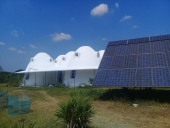We will be constructing a small 12' diameter round earthbag building in the spring. I am doing as much research as I can, but find two differing opinions at the below websites concerning exterior plaster.
Our original plan for exterior plaster/render was for clay/sand/straw plaster to fill in crevices between the earthbags, and then after curing, add a couple more layers of same plaster, and finally a couple coats of lime plaster to finish off. I read recently that unless you have actual cob walls, or clay plaster thicker than 4", the lime plaster will not stay on because the earthen plaster shrinks and expands and although the lime plaster breathes it does not expand like the earthen plaster, and within a year or two, the lime plaster will crack and crumble away. This same website mentions that you could mix the earthen and lime plasters but should be tested as the mineral content of clay may cause a chemical reaction with lime. Then the other website state that you can lime plaster on top of earthen plaster to weatherproof or make water resistent as the lime allows moisture in and out as it breathes. We do not get much rainfall here, but some snow. We don't want to actually seal an earthen plaster such as using boiled linseed oil over it. We want to allow the earthen plaster to breathe and hence the reason for wanting to coat with lime plaster. We do not want to use any cement or portland cement, at all.
I have read (somewhere) that you can add lime to earthen plaster, but details of if dry lime or lime putty were not given nor the ratios, so I don't know if this is an option or not. Can you really mix lime, dry or putty in with the clay, sand, straw plaster, and then use straight lime plaster for final two coats, without having 4" thickness of earth plaster? I like the idea of using only the earthen plaster, but I don't want to have to maintain it every year and thought with the lime plaster over it would be less maintenance issue, with maybe lime wash every few years or so, but now after reading the one posting, I am afraid to do this as I do not want the plaster to fail.
These are the two websites that concerned me with differing opinions:
http://buildnaturally.blogspot.com/2013/10/lime-over-claywhen-is-that-ok.html
(pages 7 and 8 of this pdf file):
file:///home/chronos/u-6b3dc8bb2c4a387df24972b04f63105b4eea20f0/Downloads/See%20How%20to%20Make%20Lime%20Plaster%20(1).pdf
Anyone with experience with clay plaster for beginning coats of render and final coats of render with lime plaster, your thoughts will be greatly appreciated.
Thank you.
M.A. Carey





 4
4




 2
2




 1
1












